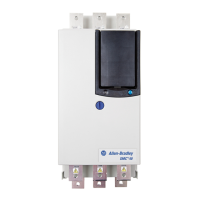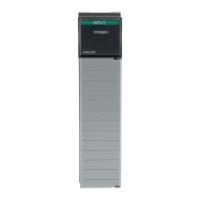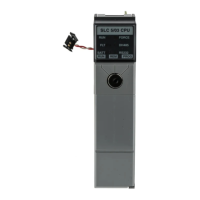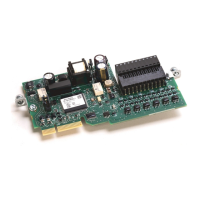Motion Event Instructions
284 Rockwell Automation Publication MOTION-RM002H-EN-P-February 2018
Usage with MAOC Instruction
When used with motion and the MAOC instruction, values in the output image
are controlled by the Motion Planner firmware in the controller. The Motion
Planner triggers the data to be sent to the module. Although, the normal program
or task scan also triggers data to be sent to the module. Data integrity is
maintained by the firmware always setting the sequence count for a given schedule
last.
The Output Cam instruction processes cam events for scheduled outputs one
coarse update period sooner than unscheduled outputs. When a programmed on
or off event is detected, a schedule is sent to the output module to turn the output
on or off at the appropriate time within the next coarse update period. The
Output Cam instruction divides the coarse update period into sixteen time slots.
For example, a coarse update period of 2 ms will yield sixteen 125 μs time slots.
Cam on/off events will be assigned to time slots based on their position within the
coarse update period. If both latch and unlatch events for a cam element are
assigned to the same time slot, they will cancel each other out. This implies that
the minimum pulse width of a cam element is greater than one time slot.
The minimum pulse width of a cam element should be greater than the 100 μs
OB16IS minimum pulse width, or the 1/16 coarse update minimum pulse width,
whichever is larger.
Important:
The Scheduled Output Module can be associated with one (1) MAOC axis/execution target only.
The MAOC instruction detects latch and unlatch events one coarse update ahead
and schedules the event to occur within the next coarse update. This is
accomplished by applying a one coarse update internal delay to each scheduled
output latch and unlatch position. When the latch or unlatch event is detected,
the delta time from the start of the coarse update to the event is calculated, and the
output is scheduled to occur at the CST or UTC corresponding to the next coarse
update period. To facilitate this, Output Cam functionality has access to the CST
or UTC captured when the current coarse update period occurred.
The MAOC instruction is able to process both scheduled and unscheduled output
bits for the 1756-OB16IS.
Scheduled outputs that are not configured for use in an MAOC’s Output Cam
Table are not allocated in the resultant Schedule Mask. You can manipulate those
outputs as general discrete outputs from separate logic. What this implies is that
for the 1756-OB16IS module, you cannot directly affect output bits 0…7 or 0...15,
but you do have the ability to modify output bits 8…15.

